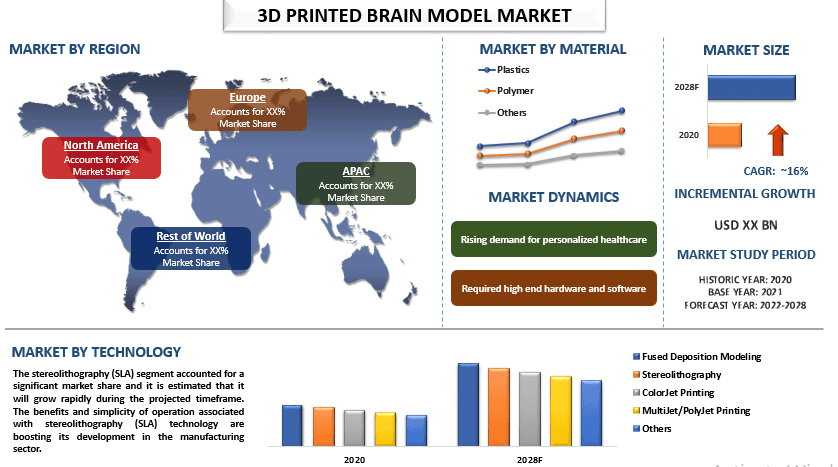- Strona główna
- O nas
- Branża
- Usługi
- Czytanie
- Kontakt
Rynek modeli mózgu drukowanych w 3D: Analiza bieżąca i prognoza (2022-2028)
Nacisk na technologię (modelowanie metodą Fused Deposition Modeling, stereolitografia, druk ColorJet, druk MultiJet/PolyJet, inne); materiały (tworzywa sztuczne, polimery, inne); i region/kraj

Oczekuje się, że globalny rynek modeli mózgu drukowanych w 3D będzie rósł w znaczącym tempie około 16% w okresie prognozy. Model mózgu drukowany w 3D wytwarza fizjologicznie, anatomicznie i mechanicznie realistyczny, spersonalizowany model mózgu, który poprawi szkolenie chirurgiczne i planowanie przedoperacyjne, a ostatecznym celem jest zapewnienie dokładnego, dostosowanego i precyzyjnego leczenia. Model oparty jest na obrazach rezonansu magnetycznego, które zostały pomyślnie przekształcone w plik stereolitograficzny gotowy do druku. Model drukowany w 3D został użyty jako szablon do formowania i odlewania dotykowo realistycznego, odkształcalnego modelu mózgu. Model mózgu drukowany w 3D potencjalnie lepiej reprezentuje ludzki system nerwowy i może być częściej stosowany w medycynie regeneracyjnej wraz z odkryciem nowych zastosowań. Zgodnie z raportem Alliance for Regenerative Medicine (ARM) z 2021 r. globalne finansowanie w medycynie regeneracyjnej wzrosło do 22,7 miliarda USD w 2021 r. z 19,9 miliarda USD w 2020 r., aby wesprzeć 2406 produktów będących w fazie badań. Rynek modeli mózgu drukowanych w 3D rozwija się dzięki rosnącym badaniom i rozwojowi narzędzi edukacyjnych i dydaktycznych dla neurochirurgii, mającym na celu poprawę technik chirurgicznych.
Stratasys Ltd.; CELLINK; CYFUSE BIOMEDICAL K.K.; Rokit Healthcare Inc.; Medprin; 3D Systems, Inc.; Formlabs; Voxeljet AG; Medivisuals Inc.; Allevi, Inc. to jedni z kluczowych graczy na rynku. Gracze ci podejmują liczne fuzje i przejęcia oraz partnerstwa, aby zapewnić klientom zaawansowane technologicznie i innowacyjne produkty/technologie.
Informacje zawarte w raporcie
„Wśród technologii, stereolitografia rozwija się ze znaczącym CAGR w okresie prognozy”
Na podstawie technologii rynek jest podzielony na modelowanie osadzania topionego materiału, stereolitografię, drukowanie ColorJet, drukowanie MultiJet/PolyJet i inne. Wśród nich oczekuje się, że stereolitografia będzie rosła ze znaczącym CAGR w okresie prognozy. Stereolitografia (SLA) zapewnia najgładsze wykończenie powierzchni narzędzi chirurgicznych, a jakość części SLA czyni ją wszechstronną technologią. Precyzja i dokładność działania związana z technologią stereolitografii (SLA) przyspiesza jej rozwój w sektorze produkcyjnym.
„Wśród materiałów polimer miał znaczący udział w rynku w 2020 r.”
Na podstawie materiałów rynek jest podzielony na tworzywa sztuczne, polimery i inne. Wśród nich polimer miał znaczący udział w rynku w 2020 r. Drukowanie 3D polimerów to nowa technologia, w której ostatnie badania przekładają się na zwiększone wykorzystanie w przemyśle, szczególnie w dziedzinie medycyny. Drukowanie polimerowe jest korzystne, ponieważ umożliwia drukowanie tanich części funkcjonalnych o zróżnicowanych właściwościach i możliwościach. Na przykład w listopadzie 2022 r. firma 3D Systems ogłosiła, że nawiązała współpracę z WeMatter w celu rozszerzenia drukowania 3D materiałów metalowych i polimerowych.
„Oczekuje się, że region Azji i Pacyfiku będzie rósł ze znacznym CAGR w okresie prognozy”
Oczekuje się, że region Azji i Pacyfiku będzie rósł ze znacznym CAGR w okresie prognozy globalnego modelu mózgu drukowanego w 3D. Wynika to głównie ze wzrostu liczby chorób neurologicznych i metod leczenia. Wynika to głównie z rosnącej liczby wprowadzanych na rynek produktów i rosnących inwestycji w opiekę zdrowotną w regionie. Na przykład we wrześniu 2021 r. firma Siemens NAEOTOM Alpha uzyskała zgodę FDA i została zaprojektowana w celu przekształcenia informacji z fotonów promieniowania rentgenowskiego, które przechodzą przez ciało pacjenta i są odbierane przez detektor, w szczegółowy obraz trójwymiarowy. Dodatkowo przewiduje się, że istnienie uznanych, dużych konkurentów rynkowych i korzystny proces refundacji pomogą we wzroście branży.
Powody, dla których warto kupić ten raport:
- Badanie obejmuje analizę wielkości rynku i prognozowania, zatwierdzoną przez uwierzytelnionych kluczowych ekspertów branżowych.
- Raport przedstawia szybki przegląd ogólnej wydajności branży na pierwszy rzut oka.
- Raport obejmuje dogłębną analizę czołowych firm z branży, z głównym naciskiem na kluczowe dane finansowe, portfolio produktów, strategie ekspansji i najnowsze wydarzenia.
- Szczegółowe badanie czynników napędzających, ograniczeń, kluczowych trendów i możliwości występujących w branży.
- Badanie kompleksowo obejmuje rynek w różnych segmentach.
- Dogłębna analiza branży na poziomie regionalnym.
Opcje dostosowywania:
Globalny rynek modeli mózgu drukowanych w 3D można dodatkowo dostosować zgodnie z wymaganiami lub dowolnym innym segmentem rynku. Poza tym UMI rozumie, że możesz mieć własne potrzeby biznesowe, dlatego zachęcamy do kontaktu z nami, aby uzyskać raport, który w pełni odpowiada Twoim wymaganiom.
Spis treści
Metodologia Badawcza do Analizy Rynku Trójwymiarowych Drukowanych Modeli Mózgu (2022-2028)
Analiza historycznego rynku, szacowanie obecnego rynku i prognozowanie przyszłego rynku globalnego rynku trójwymiarowych drukowanych modeli mózgu to trzy główne kroki podjęte w celu stworzenia i analizy adopcji trójwymiarowych drukowanych modeli mózgu w głównych regionach na świecie. Przeprowadzono wyczerpujące badania wtórne w celu zebrania historycznych danych rynkowych i oszacowania aktualnej wielkości rynku. Po drugie, aby potwierdzić te spostrzeżenia, wzięto pod uwagę liczne ustalenia i założenia. Ponadto przeprowadzono wyczerpujące wywiady pierwotne z ekspertami branżowymi w całym łańcuchu wartości globalnego rynku trójwymiarowych drukowanych modeli mózgu. Po założeniu i walidacji danych rynkowych poprzez wywiady pierwotne, zastosowaliśmy podejście odgórne/oddolne do prognozowania całkowitej wielkości rynku. Następnie przyjęto metody podziału rynku i triangulacji danych w celu oszacowania i analizy wielkości rynku segmentów i podsegmentów branży. Szczegółowa metodologia jest wyjaśniona poniżej:
Analiza Historycznej Wielkości Rynku
Krok 1: Dogłębne Studium Źródeł Wtórnych:
Przeprowadzono szczegółowe badanie wtórne w celu uzyskania historycznej wielkości rynku trójwymiarowych drukowanych modeli mózgu za pośrednictwem wewnętrznych źródeł firmy, takich jak raporty roczne i sprawozdania finansowe, prezentacje wyników, komunikaty prasowe itp., oraz źródeł zewnętrznych, w tym czasopisma, wiadomości i artykuły, publikacje rządowe, publikacje konkurencji, raporty sektorowe, bazy danych stron trzecich i inne wiarygodne publikacje.
Krok 2: Segmentacja Rynku:
Po uzyskaniu historycznej wielkości rynku trójwymiarowych drukowanych modeli mózgu przeprowadziliśmy szczegółową analizę wtórną w celu zebrania historycznych spostrzeżeń rynkowych i udziału dla różnych segmentów i podsegmentów w głównych regionach. Główne segmenty zawarte w raporcie to technologia, materiały. Ponadto przeprowadzono analizy na poziomie krajów w celu oceny ogólnej adopcji modeli testowych w danym regionie.
Krok 3: Analiza Czynnikowa:
Po uzyskaniu historycznej wielkości rynku różnych segmentów i podsegmentów przeprowadziliśmy szczegółową analizę czynnikową w celu oszacowania obecnej wielkości rynku trójwymiarowych drukowanych modeli mózgu. Ponadto przeprowadziliśmy analizę czynnikową z wykorzystaniem zmiennych zależnych i niezależnych, takich jak różne technologie i materiały trójwymiarowych drukowanych modeli mózgu. Przeprowadzono dokładną analizę scenariuszy popytowych i podażowych, biorąc pod uwagę najważniejsze partnerstwa, fuzje i przejęcia, ekspansję biznesową i wprowadzenie produktów na rynek trójwymiarowych drukowanych modeli mózgu na całym świecie.
Szacunek Obecnej Wielkości Rynku i Prognoza
Określanie Obecnej Wielkości Rynku: Na podstawie praktycznych spostrzeżeń z powyższych 3 kroków doszliśmy do obecnej wielkości rynku, kluczowych graczy na globalnym rynku trójwymiarowych drukowanych modeli mózgu oraz udziałów rynkowych segmentów. Wszystkie wymagane udziały procentowe i podziały rynku zostały określone przy użyciu wspomnianego powyżej podejścia wtórnego i zweryfikowane poprzez wywiady pierwotne.
Szacowanie i Prognozowanie: Do szacowania i prognozowania rynku przypisano wagi różnym czynnikom, w tym czynnikom napędowym i trendom, ograniczeniom i możliwościom dostępnym dla zainteresowanych stron. Po przeanalizowaniu tych czynników zastosowano odpowiednie techniki prognozowania, tj. podejście odgórne/oddolne, aby dojść do prognozy rynkowej na rok 2028 dla różnych segmentów i podsegmentów na głównych rynkach na całym świecie. Metodologia badawcza przyjęta w celu oszacowania wielkości rynku obejmuje:
- Wielkość rynku branży pod względem przychodów (USD) i wskaźnik adopcji rynku trójwymiarowych drukowanych modeli mózgu na głównych rynkach krajowych
- Wszystkie udziały procentowe, podziały i rozbicia segmentów rynku i podsegmentów
- Kluczowi gracze na globalnym rynku trójwymiarowych drukowanych modeli mózgu pod względem oferowanych produktów. Ponadto strategie wzrostu przyjęte przez tych graczy w celu konkurowania na szybko rozwijającym się rynku
Walidacja Wielkości i Udziału Rynku
Badania Pierwotne: Przeprowadzono dogłębne wywiady z kluczowymi liderami opinii (KOL), w tym kadrą kierowniczą najwyższego szczebla (CXO/VP, szef sprzedaży, szef marketingu, szef operacyjny, szef regionalny, szef krajowy itp.) w głównych regionach. Następnie podsumowano wyniki badań pierwotnych i przeprowadzono analizę statystyczną w celu udowodnienia postawionej hipotezy. Dane wejściowe z badań pierwotnych zostały skonsolidowane z wynikami wtórnymi, przekształcając w ten sposób informacje w praktyczne spostrzeżenia.
Podział Uczestników Pierwotnych w Różnych Regionach

Inżynieria Rynkowa
Zastosowano technikę triangulacji danych, aby ukończyć ogólne szacowanie rynku i dojść do precyzyjnych danych statystycznych dla każdego segmentu i podsegmentu globalnego rynku trójwymiarowych drukowanych modeli mózgu. Dane zostały podzielone na kilka segmentów i podsegmentów po przestudiowaniu różnych parametrów i trendów w obszarach technologii i materiałów na globalnym rynku trójwymiarowych drukowanych modeli mózgu.
Główny Cel Badania Globalnego Rynku Trójwymiarowych Drukowanych Modeli Mózgu
W badaniu wskazano obecne i przyszłe trendy rynkowe globalnego rynku trójwymiarowych drukowanych modeli mózgu. Inwestorzy mogą uzyskać strategiczne spostrzeżenia, na których mogą oprzeć swoje decyzje dotyczące inwestycji na podstawie analizy jakościowej i ilościowej przeprowadzonej w badaniu. Obecne i przyszłe trendy rynkowe określiły ogólną atrakcyjność rynku na poziomie regionalnym, zapewniając platformę dla uczestników przemysłowych do wykorzystania niewykorzystanego rynku, aby skorzystać z przewagi bycia pierwszym na rynku. Inne ilościowe cele badań obejmują:
- Analiza obecnej i prognozowanej wielkości rynku trójwymiarowych drukowanych modeli mózgu pod względem wartości (USD). Ponadto analiza obecnej i prognozowanej wielkości rynku różnych segmentów i podsegmentów
- Segmenty w badaniu obejmują obszary technologii i materiałów.
- Zdefiniowanie i analiza ram regulacyjnych dla trójwymiarowych drukowanych modeli mózgu
- Analiza łańcucha wartości związanego z obecnością różnych pośredników, wraz z analizą zachowań klientów i konkurencji w branży.
- Analiza obecnej i prognozowanej wielkości rynku trójwymiarowych drukowanych modeli mózgu dla głównego regionu.
- Główne kraje regionów badanych w raporcie to Azja i Pacyfik, Europa, Ameryka Północna i reszta świata.
- Profile firm na rynku trójwymiarowych drukowanych modeli mózgu i strategie wzrostu przyjęte przez graczy rynkowych w celu utrzymania się na szybko rozwijającym się rynku
- Dogłębna analiza branży na poziomie regionalnym
Powiązane Raporty
Klienci, którzy kupili ten przedmiot, kupili również










